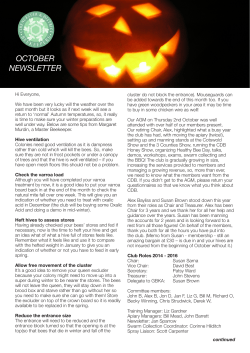
Flowing with Fat and (Bee) Honey: Evidence from Ancient Egypt Idan Dershowitz Abstract
Vetus Testamentum 64 (2014) 665-667 Vetus Testamentum brill.com/vt Flowing with Fat and (Bee) Honey: Evidence from Ancient Egypt1 Idan Dershowitz Hebrew University, Jerusalem idan.dershowitz@mail.huji.ac.il Abstract An Egyptian text sheds light on the biblical idiom ʾrṣ zbt ḥlb wdbš, helping establish the nature of both ḥlb and dbš. Keywords fat – milk – honey – Egyptian – bee Recently, I proposed in this journal that the biblical idiom ʾrṣ zbt ḥlb wdbš, typically taken to mean “a land flowing with milk and honey,” is better understood as “a land flowing with fat and honey.”2 This phrase, I argued, parallels other biblical pairings of honey with oleaginous substances (plant oil and milk fat), especially in the context of fertile land.3 In addition to biblical evidence, I cited a Ugaritic text in support of my thesis. Following a period of drought due to Baal’s demise, the god of fertility returns and makes “the heavens rain oil, the wadis run with honey.”4 1 I would like to thank Prof. Orly Goldwasser and Raanan Eichler for their helpful comments on an earlier draft of this paper. 2 “A Land Flowing with Fat and Honey,” Vetus Testamentum 60 (2010), pp. 172-176. 3 In using the term “fat,” I do not mean to comment on consistency. Plant, animal, and milk fats can all be rendered in various viscosities. 4 KTU 1.6 III 12-13. Cf. 6-7. Simon B. Parker (ed.), Ugaritic Narrative Poetry (Atlanta, 1997), p. 158. © koninklijke brill nv, leiden, 2014 | doi 10.1163/15685330-12341175 666 DERSHOWITZ In this short note, I would like to draw attention to another ancient Near Eastern text. The Egyptian Story of Sinuhe, which dates to the early second millennium BCE, contains the following passage:5 He let me choose for myself of his land, of the best that was his, on his border with another land. It was a good land called Yaa. Figs were in it and grapes. It had more wine than water. Abundant was its honey, plentiful its oil.6 All kinds of fruit were in its trees. Barley was there and emmer, and no end of cattle of all kinds. It is readily apparent that this depiction of fertility draws on imagery similar to that found in the Bible and Ugarit, thus reinforcing the reading “fat,” as opposed to “milk,” and, significantly, the land of Yaa was located in Syro-Palestine.7 This Egyptian text may have something else to contribute to the understanding of the Hebrew idiom. There has been some disagreement among linguists and Bible scholars as to the precise meaning of děbāš in this context. Historically, most scholars have been of the opinion that the idiom refers to syrup produced from dates or other fruit, whereas some—especially of late— have maintained that bee honey is intended.8 The recent discovery of a 9th or 10th century BCE apiary in Tel Reḥov introduced a new dimension into what had been a purely philological dispute. No longer can it be said that an absence of bee-honey production in Iron Age Canaan obligates us to conclude that the land was reportedly abundant in fruit syrup.9 The coupling of šemen with the unambiguously apian nōpet in Proverbs 5:3 may support a reading of děbāš as bee honey whenever paired with sebaceous 5 Miriam Lichtheim, Ancient Egyptian Literature, Vol. 1 (Berkeley, 1973), p. 226. 6 ꜥꜣ bı͗.t=f ꜥšꜣ bꜣḳ=f. See Adolf Erman and Hermann Grapow (eds.), Wörterbuch der ägyptischen Sprache, Vol. 1 (Leipzig and Berlin, 1926), pp. 424, 434; Raymond O. Faulkner, A Concise Dictionary of Middle Egyptian (Oxford, 1962), pp. 78, 79. 7 See, e.g., Michael Green, “The Syrian and Lebanese Topographical Data in the Story of Sinuhe,” Chronique d’Egypte 58 (1983), p. 54. Tellingly, Green paraphrases this passage as depicting “a land of milk and honey.” 8 See, e.g., Mekhilta de R. Ishmael to Deuteronomy 13:5 for a pre-modern discussion of the issue. For a more current submission of the bee honey hypothesis, see Tova Forti, “Bee’s Honey: From Realia to Metaphor in Biblical Wisdom Literature,” Vetus Testamentum 56 (2006), pp. 327-341. 9 See Amihai Mazar and Nava Panitz-Cohen, “It is the Land of Honey: Beekeeping at Tel Reḥov,” Near Eastern Archaeology 70 (2007), pp. 202-219. On the dating of Tel Reḥov, cf. Israel Finkelstein and Eli Piasetzky, “14C and the Iron Age Chronology Debate: Rehov, Khirbet enNahas, Dan, and Megiddo,” Radiocarbon 48 (2006), pp. 373-386. Vetus Testamentum 64 (2014) 665-667 Flowing with Fat and ( Bee ) Honey 667 products. However, since that particular passage does not relate to land fertility, the possibility remains that děbāš refers only sometimes to bee honey, and not in the idiom ʾrṣ zbt ḥlb wdbš.10 The Ugaritic text is therefore of greater relevance, as it pairs nbt (etymologically equivalent to Hebrew nōpet) with šmn in just such a context. But the Sinuhe passage is more instructive still, as both attributes appear in direct relation to the rich land, as in the Bible, and not to precipitation. Egyptian bı͗.t can refer to both a bee and its honey, and the hieroglyph that represents it is none other than a bee. (The vessel classifier indicates that the referent is a liquid substance commonly stored in a jar.)11 Together with the evidence cited above, the pairing of bee honey and oil in this ancient Egyptian text lends credence to both ḥlb=fat and dbš=bee honey in the famous biblical idiom. As a final note, it is perhaps interesting to observe that the only land outside of Canaan described in the Bible as “flowing with fat and honey” is Egypt.12 10 11 12 Two additional such pairings may be found in the Hittite Wrath of Telepinu (honey||ghee) and Purifying a House: A Ritual for the Infernal Deities (honey||oil). See William W. Hallo and K. Lawson Younger Jr. (eds.), Canonical Compositions from the Biblical World, Vol. 1 (Leiden, 2003), pp. 152, 170. Sinuhe B 82-83. See Aylward M. Blackman, Middle-Egyptian Stories (Brussels, 1972), p. 23. For a recent discussion of the bee hieroglyph, see Jochem Kahl, “nsw und bı͗t: die Anfänge,” in Eva-Maria Engel, et al. (eds.), Zeichen aus dem Sand: Streiflichter aus Ägyptens Geschichte zu Ehren von Günter Dreyer (Wiesbaden, 2008), pp. 307-350. Numbers 16:13. Vetus Testamentum 64 (2014) 665-667
© Copyright 2025





















